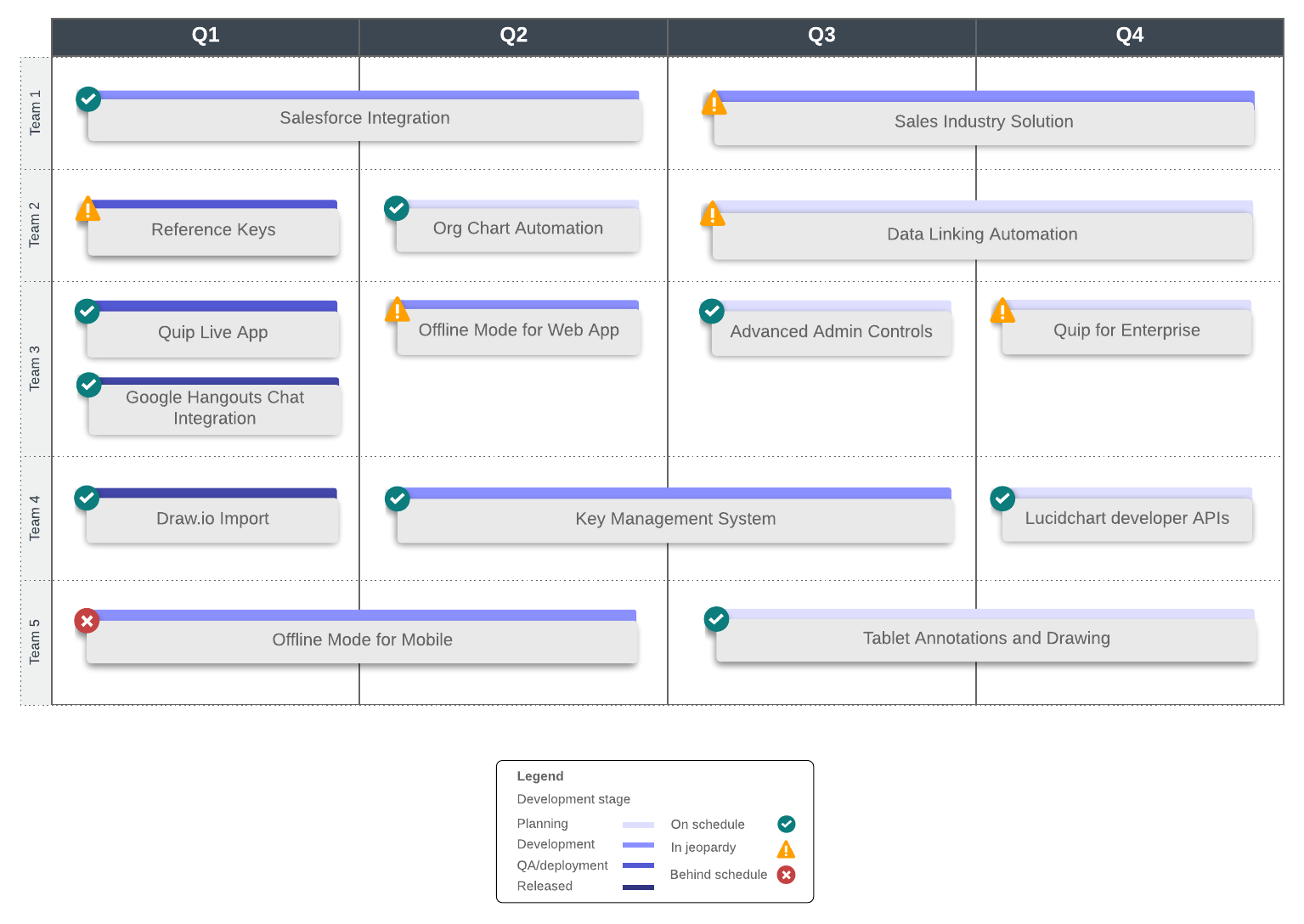
Product management tools: Find the right software to build your product stack
Lucid Content
Reading time: about 8 min
Topics:
In the software development world, developers use a combination of software, programming languages, services, and other technologies that are required to build and run a single application. This is known as the “tech stack” or “development stack.”
Similarly, product managers need a “product stack” that includes the right set of software and tools to help them:
- Track and analyze how customers use their products and services.
- Create product roadmaps to provide a visual summary of their product vision and direction.
- Design wireframes and mockups to get an idea of how applications and websites will function.
- Gather customer feedback and conduct user research.
- Communicate and present ideas and plans to teams and stakeholders
- Help remote teams collaborate with each other by sharing visual workflow diagrams and other documents that can be accessed from anywhere and worked on in real time.
- Track and manage the product development lifecycle from planning to release.
This article will introduce you to some of the available product management tools that will help you and your team be more agile so you can get your products to market quickly.
Benefits of using product management tools
A good product stack will help you facilitate everything from planning to time management and allocating resources. It can also help with change management and with overseeing multiple projects being developed at the same time. Your product stack should be comprehensive so that nothing falls through the cracks. Here are some benefits of using project management tools:
Convenient team collaboration
Most development teams are spread out across multiple sites and include people who work remotely. This makes it difficult or impossible to bring everybody together in the same physical location to make sure everybody is on the same page.
Cloud-based product management software lets your team access, update, and collaborate on shared documents—workflows, Kanban boards, burn-down charts, schedules, reports—in real time from anywhere in the world. This keeps the whole team up to date on current status, progress, and goals.
Enhanced schedule management
Product management tools make it easy to display schedules such as Gantt charts that are easy to read and understand. These can be displayed prominently on large screens across multiple sites so that teams can easily refer to them as needed. Schedules can be updated in real time so everybody knows what’s going on.
Better resource management
Resource management helps you keep your teams optimized and working smoothly. Resource management software can help you identify bottlenecks and get insights into when to bring in more people or when to spread out tasks to other teams that have the necessary bandwidth.
Easier task delegation
Assigning tasks across multiple departments and locations can be difficult. Product management tools make it easy for you to simply insert tasks into the project timeline and assign them to the appropriate team members. You can then send along detailed instructions and coordinate with team members on task execution.
Improved communication with clients
In video conferences with clients, you can give them access to charts, diagrams, and other documents so they can easily see your team’s progress. These meetings are an efficient use of time as customers give you valuable feedback and as you manage their expectations. Clear communication leads to increased customer satisfaction.
Streamlined integration of new team members
Sometimes you need to bring in a new team member midway through a project. Your product strategy tools include the project information these new hires need to review to quickly begin making contributions to the project.
Successful product launches
The right mix of tools in your product stack helps to ensure that you consistently manage and launch products. Here’s why:
- You have a central, easily accessible location for cross-team collaboration.
- You can track progress and make adjustments on the fly.
- You are able to clearly communicate so everyone is informed and up to date.
- You can continually evaluate, refine, and improve processes.
Greater agility
The best product management tools help you to adhere to standardized Agile methodologies of continuous improvement, quality products, and shorter development cycles.
Best product management tools
Let’s talk about some of the best product management tools to help you build an effective toolkit that will help you to stay on top of your projects. We’ll tell you what each tool does, where it fits in your product strategy workflow, and how it can make your life easier.
Project management and collaboration
These products are widely used by product managers and development teams working in an Agile environment. Project manager software is used throughout the project lifecycle to track and manage project iterations, tasks, resources, and product backlogs. These products also let you reassign tasks and delegate work to keep the workflow moving.
- Asana: Assign and track tasks, communicate with team members, collaborate on documents, and stay in sync with your team.
- Trello: This web-based Kanban board makes it easy to visually manage projects and tasks.
- Jira: A popular issue tracking and Agile project management app.
- Confluence: A shared, collaborative workspace that allows you to create and organize all of your work in one place.
- monday.com: Create workflow apps to run your processes, track projects, and manage your workload
Diagramming and roadmapping
Use these tools during the planning stages of your projects. Roadmap and planning tools make your life easier because they help you define a strategy that mandates specific steps and when they need to be taken to develop a product. This keeps the team focused and reduces feature creep.
Use these tools in collaboration with development teams and other stakeholders. Evaluate what must go in the product, what would be nice to include, and what will not be included.
- Lucidchart: Cloud-based app used for intelligent diagramming and data visualization. Lucidchart includes various product roadmap templates to help you build your product strategy.
- airfocus: A roadmapping tool that automatically calculates priorities to help you make better decisions.
- ProdPad: Capture ideas and feedback and build product roadmaps.
- Aha!: Web-based strategy and roadmapping tool to help you define a strategy and prioritize your work.

Designing, wireframing, and prototyping
Wireframing and prototyping applications let you create documents that describe the basic structure and functions in applications and web pages. A prototype is an early model of your product or design. It usually includes interactive elements that simulate how the product will work.
You may want to use wireframes throughout the development cycle to help stakeholders get a better idea of the product’s design and functionality. Giving them the chance to interact with wireframes and prototypes is more effective than just explaining what the product is and does.
- Lucidchart: Easily build and share interactive wireframes and mockups online.
- Adobe XD: On-premise UX tool for creating interactive designs for mobile and web apps.
- Balsamiq: Easy-to-use software that is good for beginners who want to create low-fidelity wireframes.
- InVision Freehand: Lets you create wireframes on a web-based whiteboard where everybody on the team can collaborate and contribute to the designs.
- Figma: Design tool that lets design teams collaborate in real time.

Analytics and customer feedback
Product analytics software helps you measure what your users need so you can develop better products going forward. By analyzing customer behavior when they use your products, you can make reasonable predictions about future customer needs and expectations.
You can gather data and analyze it at any time to help you plan for future product releases. Analytics can make your life easier by helping you to identify trends and determine what works well and what doesn’t.
- Google Analytics: This is a widely used, free tool that helps you measure traffic and how customers interact with your site.
- Google Forms: You can create simple surveys and forms so your customers can give you feedback.
- Pendo: Lets you gather data on in-app usage to see how customers interact with your applications. It includes surveys and feedback functions so you can learn what your customers like, don’t like, and need.
- Mixpanel: A business analytics service that lets you track customer interactions with web and mobile applications. It also includes tools for targeted communication with your customers.
- Amplitude: Gather data so you can answer questions about what happened, why it happened, and what to do next to improve.
- SurveyMonkey: Create customer satisfaction surveys to let you know your customer needs, wants, and expectations.
As enterprises expand across the world is now more important than ever to make sure that you have a product stack toolkit that allows you to work closely with team members no matter where they are located. There are many different product management solutions to help you define product strategies, collaborate in real time, facilitate virtual team meetings, manage schedules and workflows, and assign resources where they are needed.
All you have to do is choose your favorites and build a product stack that works for you.

Sign up for Lucidchart to begin building product roadmaps, wireframes, mockups, and other visuals that push product development forward.
Try it nowAbout Lucidchart
Lucidchart, a cloud-based intelligent diagramming application, is a core component of Lucid Software's Visual Collaboration Suite. This intuitive, cloud-based solution empowers teams to collaborate in real-time to build flowcharts, mockups, UML diagrams, customer journey maps, and more. Lucidchart propels teams forward to build the future faster. Lucid is proud to serve top businesses around the world, including customers such as Google, GE, and NBC Universal, and 99% of the Fortune 500. Lucid partners with industry leaders, including Google, Atlassian, and Microsoft. Since its founding, Lucid has received numerous awards for its products, business, and workplace culture. For more information, visit lucidchart.com.
